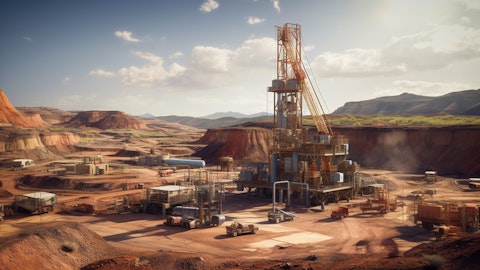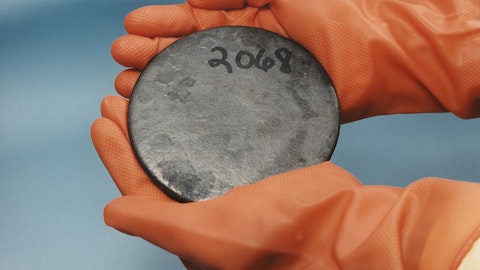Gordon Johnson: Yeah. That’s very helpful. That was the biggest that I saw, the Russian retaliation was really be what caused prices to move in. I agree that’s not price in. One quick follow-up, if I can. There seems to be a constituency of people out there who are saying, Chemical forward sold a lot of their pounds at $70, and thus, they’re not going to benefit from this increase in prices. Yet, when I go through your financials, and just correct me if I’m wrong, it looks like to me, you guys have only committed 20% of your reserves. So that leaves about 800 million pounds for future contracts. And from what I’m hearing in the market, those contracts are being signed at floor prices of 80 with selling at 135. Is that accurate? Can you comment on that? Thanks for the question, guys.
Tim Gitzel: Yeah, Gordon. Thanks for that question. You’re seeing our song there because you’re accurate with what you said. I think we have sold about 20% of our total reserve resource base and more to come. We’ve got lots to go. So Grant, do you want to answer that again?
Grant Isaac: Yeah. Gordon, thanks for that question. And it is something that we occasionally hear. And let’s just go through that in a little bit of detail. And sorry for folks that are very familiar with this explanation. But for those who aren’t, I think it bears a little bit of time. There is a notion out there that a producer in the uranium space should produce uranium and sell it into the spot market. And I think if that debate isn’t clearly over for folks, it’s just because they’re not paying attention. We saw significant downward price action in the spot market in March on the back of a couple hundred thousand pounds dangled over the spot market. So you’re talking about an industry consuming about 180 million pounds a year and a couple of hundred thousand pounds being aggressively moved into the spot market had a $6, $7 effect over the course of a couple of days.
And why is that? It’s because of a very simple fact. And that is there is not a reactor anywhere on the planet that is loading a fuel bundle in 2024 that needs uranium in 2024. The uranium that’s in that fuel bundle was bought years ago, at least in 2021 and probably even years before that. So there is never high quality fundamental in-year demand for uranium. Utilities instead are looking for their material out into the future. That’s the high quality fundamental term market. And that is the market that matters to a uranium producer. And when you look at that market, here’s a really important fact. Cameco never sells below the market. So if the market is the term market, what’s being negotiated today, Cameco is always able to capture leading prices in the market.
We are able to take advantage of our incumbent production, our brownfield leverage, our reputation as a reliable supplier and discover the best pricing in the market in terms of floors and ceilings and market-related contracts or the base escalated portion, the fixed portion in the term market. We don’t miss that market at all. In fact, in many cases, we’re helping lead the discovery of prices in that market because of all the advantages we bring to the table relative to somebody who might be producing from a jurisdiction that’s not considered sovereign safe or somebody who doesn’t have the reputation of reliable supply like, we do or doesn’t have multiple sources of supply like we do. So those incumbent advantages create this opportunity for us to capture leading value going forward.
So where the market is today is exactly where Cameco is. We never miss that market. And the inverse is not true. If we had if we had preserved 5 million pounds to sell through the spot market when it hit $106. First of all, the market would never hit $106 because it would see that material sitting there. And the second, we showed up with 100,000 pounds of fresh production, the market would back up. And you don’t even have to take my word for it. Look at what happened Kazatomprom during their volume strategy days, when they were selling material through the spot market in big volumes or look at what happened to Paladin in their spot exposure dates. So no surprise looking forward, the responsible producers of uranium have landed on a very common message, which is you build homes for your production before you call for it.
You stay off the spot market because it’s not capable of absorbing those volumes because there’s never any high quality in-year demand for uranium. And that strategy is what captures the most amount of value going forward. And when you’re a producer like Cameco, you’re at the top of that market in finding that forward value. So you look at our Cameco, our exposure is second to none. And our pipeline of reserves and resources means we have about 800 million pounds. We haven’t even tried to sell yet. That is best-in-class exposure to this constructive market.
Gordon Johnson: Thanks for the questions.
Tim Gitzel: Thanks, Gordon.
Operator: Our next question comes from Andrew Wong of RBC Capital Markets. Please go ahead.
Andrew Wong: Hey, good morning. Thanks for taking my questions. So just wanted to go back to contract terms. Can you just talk about the escalators that are being built in the contracts today were in a more inflationary environment? Rates are higher, demand is stronger, how those escalators gone up? And maybe just talk about how those might affect pricing in the future period since we don’t really hear much about the escalators?
Tim Gitzel: Thanks, Andrew. Grant?
Grant Isaac: Yeah. The situation for escalators on contracts has really improved dramatically for suppliers of uranium. And remember, what we’re talking about here is in a term contract, there’s those two bookends. You can have a term contract that’s base-escalated. So you start at today’s term price, average term price of $77.50. And then the negotiation is, how does it escalate to first deliveries and then how does it escalate through the delivery window. The other types of escalators are actually on market-related contracts because the floors and the ceilings have escalators built into them. So a floor price you get today is subject to an escalator, a ceiling price subject to an escalator. And when I say the environment for escalators has improved, what I mean is that in the post-Fukushima window when we saw a lot of material hitting the market, a lot of uncommitted material oversupply.
We actually saw some producers who were willing to even discount a standard inflation indicator. So you take a CPI indicator and they would offer 0.75 of the normal CPI indicator. Now what we’re seeing is indicators that are capturing escalation, at least at industrial escalation and in some cases, having success building in regulatory cost or industrial cost escalators. And this is just a function of the security of supply pivot that I talked about. And it’s exactly why when the market is oversupplied and prices are soft, Cameco chooses to leave pounds in the ground rather than pulling them out of the ground and trying to pound them into a market where you don’t have any negotiating leverage. And now as this market has changed and security of supply is back in the market, it gives incumbent producers, incredible advantages and escalators are one of those advantages.
So that environment has definitely changed.
Andrew Wong: Okay. That’s great. And then maybe just switching to something else here. Can you talk more about the Don Lake project? Looked like drilling and exploration there hit some pretty significant mineralization last year. What’s the exploration plan for that project going forward and maybe when might we hear some of those results?
Tim Gitzel: Yeah. Thanks, Andrew. Yeah, that — we don’t often talk about exploration program, which is probably one of the best in the world, and we’ve got some of the best property in the world, including the Don Lake property, which is close to our existing infrastructure. So yeah, we have had a bit of success there. Sean, do you want to say a few words about our Q ‘22 or Don Lake project and just where that’s at?
Sean Quinn: Sure. And I’ll just start by noting it’s across the fence line. We have ISO Energy in the hurricane deposit. But we had a very active winter program. And we are analyzing the results, sharing them with our joint venture partner in Orano. And then, we’ll be moving into a summer drill program, assessing the results of that. And I think we might anticipate having some results to share with the market after the conclusion of that summer program.
Tim Gitzel: Thanks, Andrew.
Andrew Wong: Okay. Great. Thanks.
Operator: Our next question comes from Alexander Pearce of Bank of Montreal. Please go ahead.
Brian MacArthur: Great. Thanks. Good morning, all. And so just turning back to contracting again. It looks like you may have added a few million pounds near to midterm contracting book. I think you flagged this 28 million pounds per year now for the next five years. In the previous quarter, you provided a total number of contracts, so it’s under contract. So I wondered if you could provide an updated number for us there?
Tim Gitzel: Thanks, Alex. We…
Grant Isaac: Sorry, Tim.
Tim Gitzel: Go ahead, Grant. Yeah.
Grant Isaac: Yeah. Sorry, we moved away from kind of giving those quarterly updates, Alex, on where we were at with contracting. We did it for a period of time because we were seeing the market recovery before others were seeing it. And we thought we were there to play a pretty important role in convincing folks that contracting was underway, and we were seeing the return of term contracting, but now the data are pretty clear. So what we want to do, obviously, is kind of go back to our maximum negotiating position, which is on an individual basis, not revealing what’s committed at any time in the market when we’re negotiating with customers. And that’s just a position we want to be in because we just don’t think we have to convince anybody that term contracting cycle is underway.
Now to your question about adding some near-term demand, what I want to emphasize there is. You often hear us talking, Alex, about staying off the spot market. So I don’t want anybody to interpret us adding near-term commitments as — well, you’re saying one thing and doing the other, occasionally, we’ll be in a term contract negotiation with the utility. And we’ll be talking about a classic term window, starting two years from now going out for seven to 10 years. But that utility might say to us, but we’d really like you to find some material in the near term. So it is fundamental end user demand. It’s not material. We’re putting to a trader to then churn through the spot market. And it’s also demand that we can deploy when we want to deploy it.
So we have it in our back pocket. It’s like our up to 2 million pounds of potential market purchases. We can deploy it when it makes sense for maximum value creation for us. So it’s a good strategy for us to follow when it works, but there are other times where we simply say, we can’t find you any material in the near term. So sometimes we will add those commitments, but it’s never commitments to a trader for material that gets churned through the market because that is not value creating.
Brian MacArthur: Okay. Fair enough. Thanks, Grant. Maybe I can ask the second question then. Just in terms of where you stand on the McArthur River expansion. Obviously, the last update you’re investigating what it could cost?
Tim Gitzel: Same probably as last quarter, Alex, we are investigating where we’ve got a team looking at whether we can expand and what it will take to expand. Obviously, as we’ve said over and over, kind of ad nauseam, we’ll let the market call for those pounds. And then, we’ll move ahead and bring up the production. So we’re just doing the background work that we need to do now to look at the different circuits in the mill and in the mine. We know we can get there. We’re just kind of evaluating what it will take to get there. So we’ll have more news on that as the year goes on, but we’re progressing.
Brian MacArthur: Great. Thanks, Tim. Thanks, Grant.
Tim Gitzel: Yeah. Thanks, Alex.
Operator: Please note, we are nearing the 10-minute mark for questions and any we don’t get you, can reach out to the IR team. Our next question comes from Orest Wowkodaw, Scotiabank. Please go ahead.





